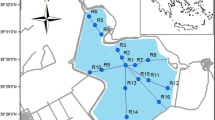Abstract
Ham's Lake was destratified in the summers of 1977 and 1978 by pumping surface water to the bottom. However, an arm was prevented from mixing by a submerged dam of a former farm pond and remained stratified. The concentration of manganese in the water increased to over 5 000 µg 1−1 in the hypolimnion of the anoxic arm in summer. Soluble manganese averaged 28% of total concentration. Total iron concentrations were relatively high in the water and sorbed iron values were extremely low in the sediments. Soluble iron averaged 12% of total concentration. Zinc values were low in the water and sediments. Chaoborus punctipennis and Chironomus riparius concentrated iron and zinc and discriminated against manganese. Concentration factors were unaffected by mixing.
Similar content being viewed by others
References
Bohn, A. & McElroy, K. O., 1976. Trace metals (As, Cd, Cu, Fe, and Zn) in Arctic Cod, Boreogadus saida, and selected zooplankton from Strathcona Sound, North Baffin Island. J. Fish. Res. Bd Can 33: 2836–2840.
Cover, E. C., 1980. Calorie content and iron, manganese, and zinc concentration of sediment, chaoborids, and chironomids of Ham's and Arbuckle lakes. Ph.D. diss., Okla. State Univ., Stillwater, 99 pp.
Cross, F. A., Duke, T. W. & Willis, J. N., 1970. Biogeochemistry of trace elements in a coastal plain estuary: distribution of manganese, iron, and zinc in sediments, water, and polychaetous worms. Chesapeake Sci. 11: 221–234.
Cushing, C. E., 1979. Trace elements in a Columbia River food web. Northwest. Sci. 53: 118–125.
Cushing, C. E. & Rancitelli, L. A., 1972. Trace elements analyses of Columbia River water and phytoplankton. Northwest Sci. 46: 115–121.
Dean, J. M., 1974. The accumulation of 65Zinc and other radionuclides by tubificid worms. Hydrobiologia 45: 33–38.
Ferraris, C. & Wilhm, J., 1977. Distribution of benthic macroinvertebrates in an artifically destratified reservoir. Hydrobiologia 54: 169–176.
Garton, J. E., 1976. Physicochemical and biological condition in two Oklahoma reservoirs. Rep. Bur. of Reclamation, Denver, Co. 138 pp.
Harvey, R. S., 1971. Temperature effects on the maturation of midges (Tendipedidae) and their sorption of radionuclides. Health Phys. 29: 613–616.
Hutchinson, G. E., 1957. A Treatise on Limnology, Vol. I: Geography, Physics, and Chemistry. John Wiley, New York, 1015 pp.
McClintock, N. L. & Wilhm, J., 1977. Effects of artificial destratification on zooplankton of two Oklahoma reservoirs. Hydrobiologia 54: 233–239.
Mortimer, C. H., 1942. The exchange of dissolved substances between mud and water in lakes. III and IV. J. Ecol. 30: 147–201.
Mortimer, C. H., 1971. Chemical exchanges between sediments and water in the Great Lakes-speculations on probable regulatory mechanisms. Limnol. Oceanogr. 16: 387–404.
Namminga, H. & Wilhm, J., 1977. Heavy metals in water, sediments, and chironomids. J. Water Pollut. Contr. Fed. 49: 1725–1731.
Pilkey, O. H. & Goodell, H. G., 1963. Trace elements in recent mollusk shells. Limnol. Oceanogr. 8: 137–148.
Robinson, K. M., 1981. Reservoir release water quality improvement by localized destratification. M.S. thesis, Okla. State Univ., Stillwater, 98 pp.
Sias, M. & Wilhm, J., 1975. The distribution of copper, lead, and zinc in the sediment and water of Lake Carl Blackwell. Proc. Okla. Acad. Sci. 55: 38–41.
Stevenson, R. A. & Ufret, S. L., 1966. Iron, manganese, and nickel in skeletons and food of the sea urchins Tripneustes esculentus and Echinometra lucunter. Limnol. Oceanogr. 11: 11–17.
Toetz, D. T., 1977. Effects of lake mixing with an axial flow pump on water chemistry and phytoplankton. Hydrobiologia 55: 129–138.
Wetzel, R. G., 1975. Limnology. W. B. Saunders, Philadelphia, Pa. 735 pp.
Wilber, W. G. & Hunter, J. V., 1977. Aquatic transport of heavy metals in the urban environment. Water Res. Bull. 13: 721–734.
Wilhm, J. & McClintock, N., 1978. Dissolved oxygen concentration and diversity of benthic macroinvertebrates in an artificially destratified lake. Hydrobiologia 57: 163–166.
Windom, H. L. & Smith, R. G., 1972. Distribution of iron, magnesium, copper, zinc, and silver in oysters along the Georgia coast. J. Fish. Res. Bd Can. 29: 450–452.
Wolman, A. & Stegmaier, R. B., 1940. Manganese in the Loch Raven Reservoir. J. Am. Water Works Ass. 32: 2015.
Author information
Authors and Affiliations
Rights and permissions
About this article
Cite this article
Cover, E., Wilhm, J. Effect of artificial destratification on iron, manganese, and zinc in the water, sediments, and two species of benthic macroinvertebrates in an Oklahoma lake. Hydrobiologia 87, 11–16 (1982). https://doi.org/10.1007/BF00016657
Received:
Issue Date:
DOI: https://doi.org/10.1007/BF00016657



